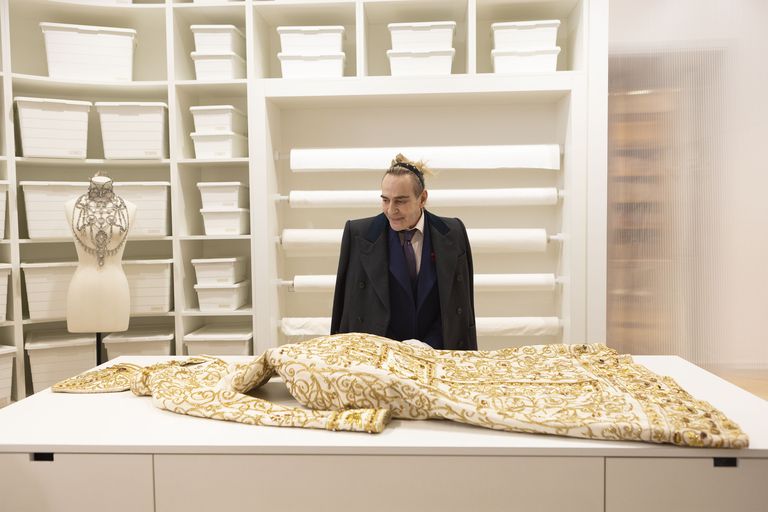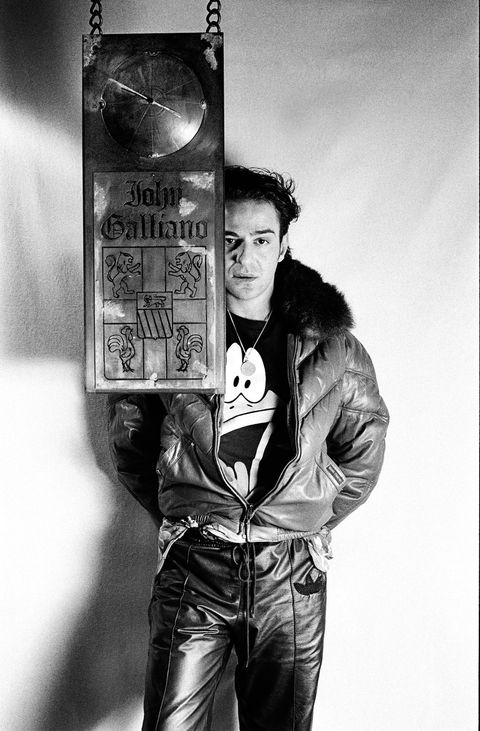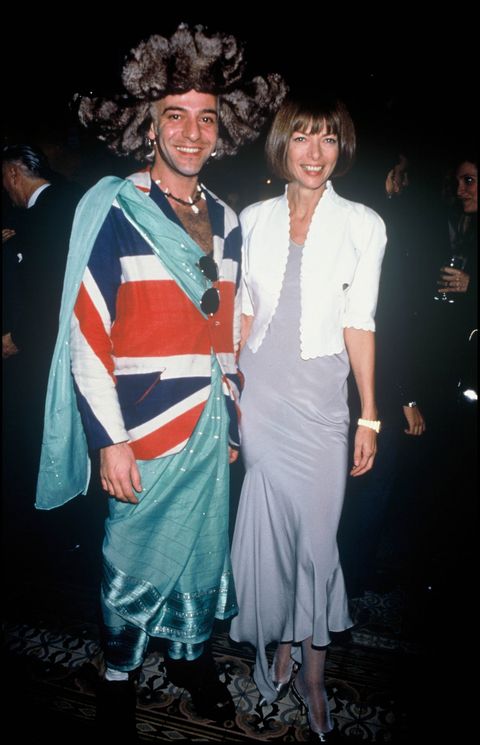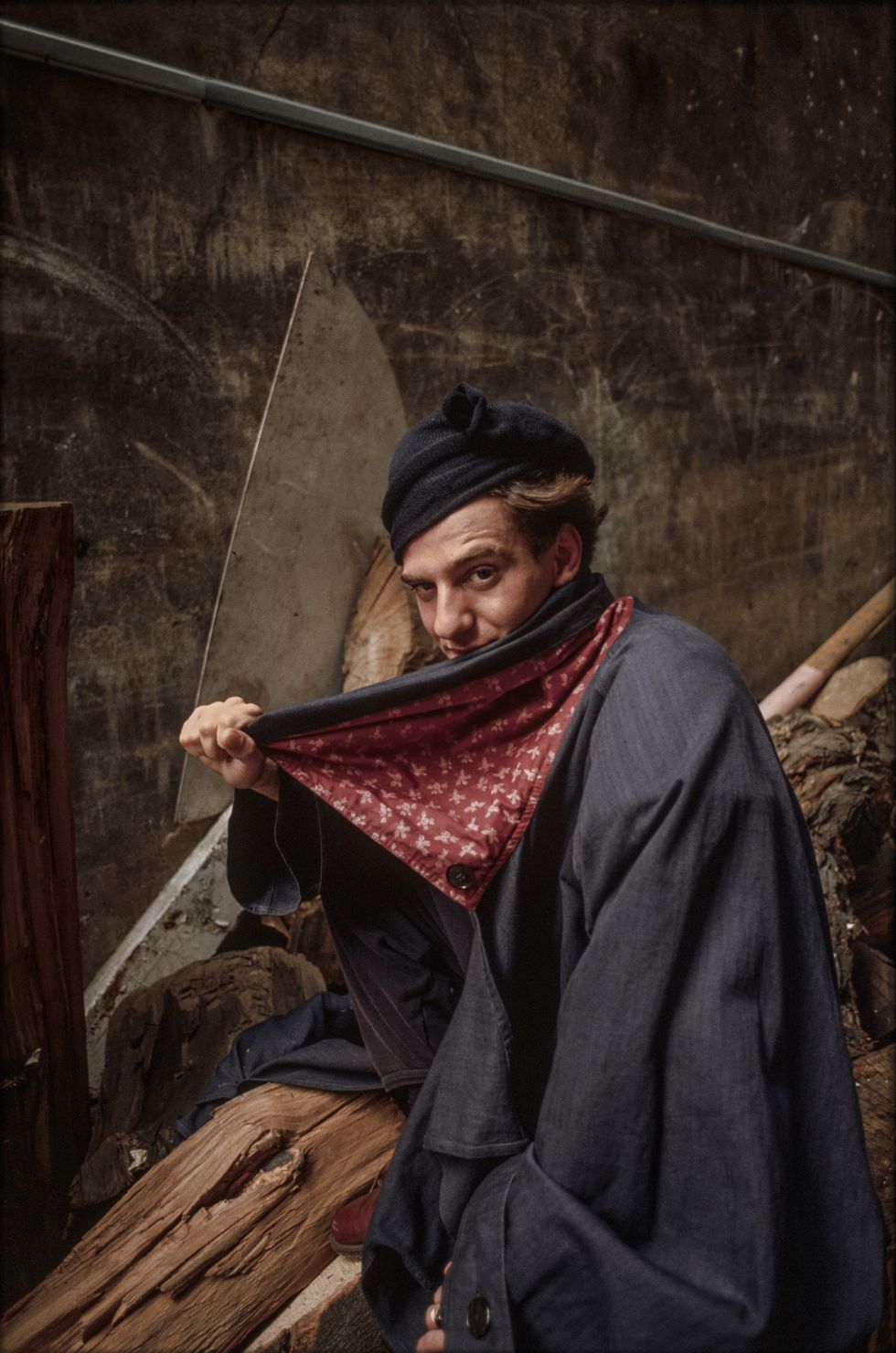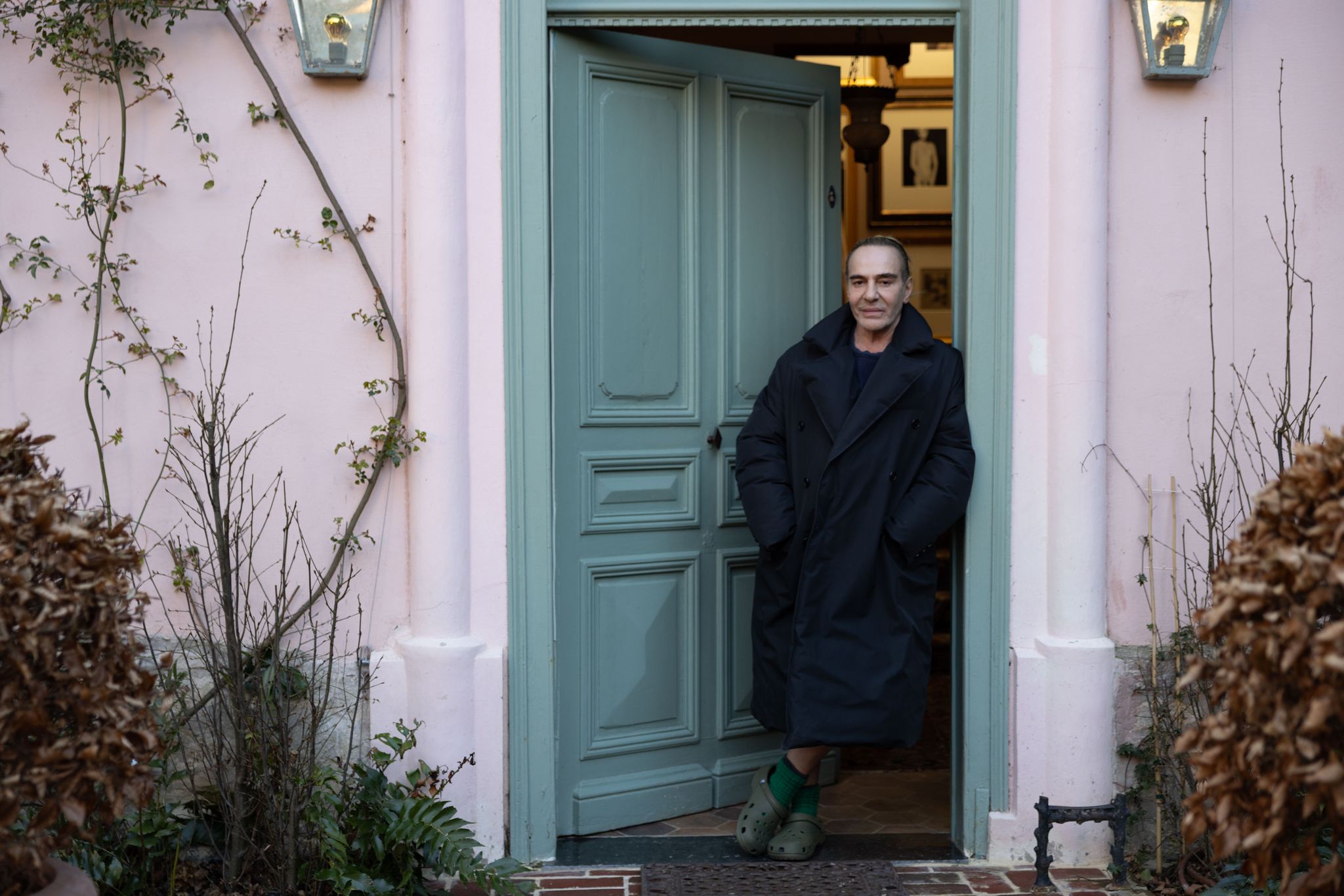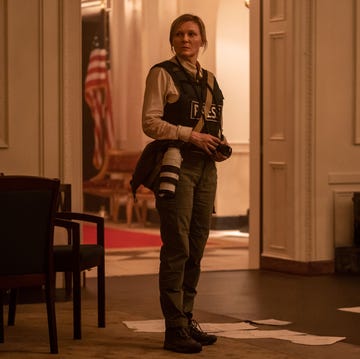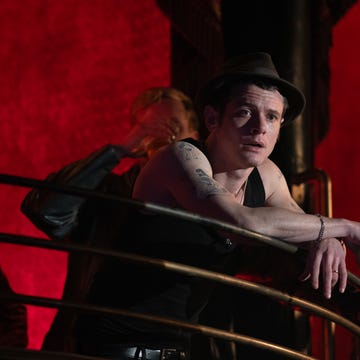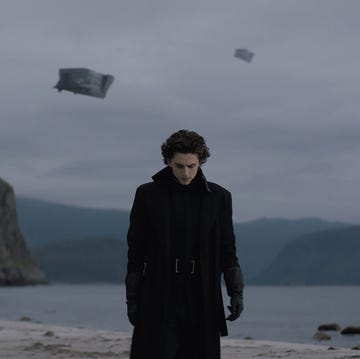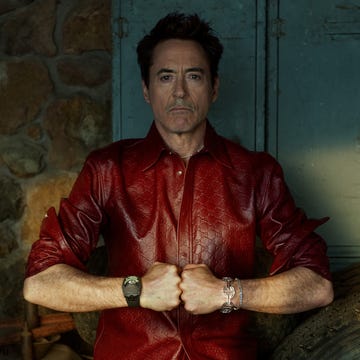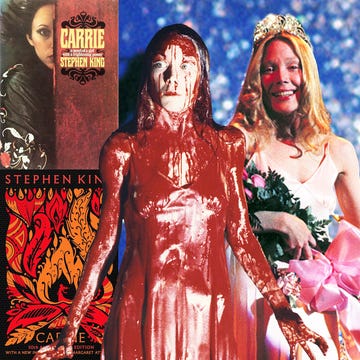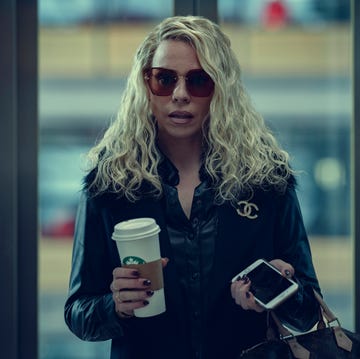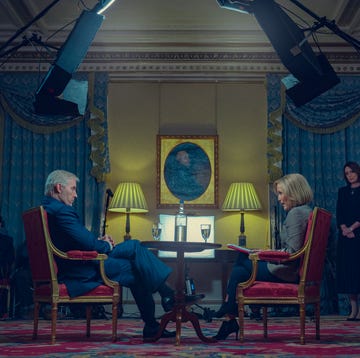Like the models that walk in them, fashion shows vanish as fast as they appear — with just the briefest moment, hand on jutting hip, in the spotlight. Fashion is intended to be ephemeral. You can’t make clothes for the ages if you’re hoping to sell people something new each season. Or, better yet, each week, or day, or hour, or minute. Fashion is about novelty, and progress. It’s about moving forwards and wanting more. If designers look frequently to history for inspiration, then that’s mostly so they can reinterpret and repackage the past for future sales. The biggest threat to the industry’s bottom line? “Vintage.”
All the more remarkable, then, that more than a month after it was staged fashion people are still rhapsodising about John Galliano’s recent couture show for Maison Margiela, the label the designer has worked at since 2014. It is the most recent triumph in a long career that has seen many of those, as well as disasters.
As the New York Times fashion editor Vanessa Friedman reported, in the most measured account I could find (the only measured account I could find), the Margiela show “sent the watching hordes into ecstasies of praise and adoration, and inspired talk of ‘history’ and ‘genius’ and ‘the sublime.’” Having demonstrated her own clear-eyed critical distance, even the un-gushy Friedman then succumbed somewhat, suggesting that Galliano’s latest was “the sort of immersive show that hasn’t been seen in more than a decade. Maybe two.”
You can watch it on YouTube and get a sense of what the excitement was about. Held in Paris in January, under the Pont Alexandre III, with the Seine riverbank reconceived as a fin de siècle nightclub, the show is spectacular, theatrical, witty, weird, and otherworldly. The casting, the hair, the make-up, the mise en scène: all are exquisitely conceived and executed. And the clothes? The clothes are fabulous. They’re gorge. They’re incred.
So perhaps all the hype is justified. And it’s not like we, and he, haven’t been here before. There are fashion people who still rhapsodise about much earlier John Galliano shows, some of which are as feted as any ever staged. Les Incroyables, his revelatory, and revolutionary, graduation show, from 1984. The Schlumberger show, aka the Black show, in Paris in 1994, in which the designer, at that time on his uppers, proved once and for all that he was among the all-time greats, worthy of mention alongside predecessors such as Christian Dior and Yves Saint Laurent.
Footage of Les Incroyables and the Black show can be seen in High & Low — John Galliano, the British filmmaker Kevin Macdonald’s new documentary about Galliano’s bumpy rise, sensational fall, and shaky rise again. Macdonald’s film was finished before the Margiela show but, given how hyperbolically that was received, High & Low will surely benefit from the renewal of interest in and appreciation for the designer’s work. In fashionland, Galliano is hot — again.
High & Low, though, is not really a film about fashion. For Macdonald’s purposes, Galliano could have been a movie star, or a famous painter, or a leading sportsperson — anyone venerated, overindulged, isolated, and then exposed and condemned. Instead, his is a film about cancel culture, and art monsters, and what to think about them. Not to sound un soupcon superficial, but if these concerns feel a little last season, even a bit 2022, then that’s always the risk with trying to be of the moment. You might get overtaken by events…
As I write this, the antisemitic rapper formerly known as Kanye West is spending a second week atop the Billboard charts in America and incidents of antisemitism are soaring in the UK and around the world. And we could just as easily find frightening examples of Islamophobia, and every other form of intolerance on the rise. The struggle for absolution of an alcoholic couturier might seem small beer by comparison.
The facts are these: in February 2011, a video appeared online of John Galliano, at that time the artistic director of Christian Dior, where he had reigned supreme since 1996. Clearly drunk, Galliano had been filmed the previous December sitting outside Café La Perle, a bar in the Marais, hurling insults at fellow customers. “Fucking ugly Jewish bitch,” he said to one woman. “Fucking Asian bastard,” he said to her friend. He went on to make a string of similarly offensive remarks about the couple.
It was later revealed that on two separate occasions at the same bar, he had spat poison at unsuspecting members of the public. “I love Hitler,” he was filmed saying. Under the Nazis, he said approvingly to one woman, “People like you would be dead. Your mothers, your forefathers would all be fucking gassed.”
After Dior sacked him, Galliano was prosecuted for making racist remarks in public, an offence in France. At his trial he claimed to remember none of the incidents, due to his triple addiction to booze, sleeping pills and Valium. He said he had been “pushed to the edge” by the demands of his job. He apologised for “the sadness” his actions had caused. He was found guilty and fined.
“It is doubtful,” said the Guardian report of his September 2011 conviction, “whether Galliano will ever be able to redeem himself at the top of the fashion world.” That turns out to have been rather naïve. (French word.) Perhaps the newspaper’s Paris correspondent never saw Les Incroyables?
Credit to Macdonald: he doesn’t mess about. High & Low opens with the video footage that brought Galliano down. “A disgusting thing, foul thing I did… horrific,” Galliano says to Macdonald’s camera. It later turns out, in a horribly telling moment, that Galliano is, or professes to be, unaware of his multiple offences — believing, until told otherwise on camera by his boyfriend, that there was only one incident. Which does slightly call into question the assertion that he has worked hard on trying to understand what he did and why.
Perhaps in a bid to explain that, or perhaps just because Galliano’s story makes for a rollicking picaresque, High & Low scrolls back to the beginning: London, 1980, the birth of the New Romantics, and the reminiscences of the painter David Harrison, early mentor to the young John, then a club scene neophyte — “very suburban”, says Harrison, enjoying himself — and a student at Saint Martins, where it was quickly apparent that his talent far outstripped that of any of his contemporaries. He soon launched his own, eponymous label.
Next we learn about the designer’s childhood. The son of a macho plumber and his glamorous Spanish wife, Galliano lived in Gibraltar until he was six, at which point the family relocated to south London, where the boy Juan Carlos attended a strict Catholic school. We hear that his father beat him and called him “maricon” (“faggot”). It is pointed out, not inaccurately, that the overarching theme of every major fashion show he would go on to stage as an adult could be reduced to a single word: “escape.”
The young Galliano was apparently transported by Abel Gance’s silent-era classic, Napoleon, a fact of which Macdonald makes much. Too much? It sometimes feels there are as many shots in High & Low of the designer striking Imperial poses in a bicorne hat as there are of Joaquin Phoenix doing the same in Ridley Scott’s biopic of the bellicose Corsican. Galliano was further inspired by ballet (cue clips from Powell and Pressburger’s The Red Shoes) and a hodgepodge of influences that he alchemised into his intricate, romantic and highly original vision.
More pertinent are the interviews with those who worked behind the scenes as Galliano’s friends and collaborators: Amanda Harlech, the high-born stylist who became his muse, before he discarded her (Karl Lagerfeld, never one to miss a trick, was delighted to offer her refuge at Chanel); Johann Brun, his first financial backer; Tim Blanks and Hamish Bowles, journalists who followed his rise and fall; Kate Moss, with whom he formed a close bond, as he seems to have done with all the supermodels.
Jeremy Healy, the DJ and former frontman of the post-punk popsters Hayzee Fantayzee, remembers first encountering Galliano when Healy’s then girlfriend walked as a model in one of the designer’s early shows — autumn 1985, The Ludic Game — throwing dead mackerel into the audience. (Zoolander’s got nothing on this, and it’s only fair to acknowledge that for all the sombre interviews, Macdonald’s film is often very funny, because fashion so often is very funny. Galliano’s controversial Les Clochards — his Tramps show, from spring 2000 — was inspired by the rough-sleepers the designer would pass each morning as he jogged along the Seine, as satirised, brilliantly in Ben Stiller’s 2001 movie, where it becomes Will Ferrell’s collection, Derelicte.)
From the beginning Galliano’s mood swings were extreme. He was up, and then he was down. “I never completely understood him,” says Johann Brun, still baffled. “After every show he would crash.”
By the dawn of the 1990s, Galliano was a critical darling, but the clothes weren’t selling and his behaviour was out of control. The model Marie-Sophie Wilson remembers “two Johns” — the angel and the devil. “He was a bad drunk,” she says. Tim Blanks recalls Galliano at a nightclub taking out his cock and pissing on fellow revellers. Not chic.
(I have my own memories of Galliano from this time, having encountered him on a handful of occasions in London clubs, unmistakable in his Union Jack blazer and pencil moustache. He was friendly and fun if a little… intense.)
In 1994, in swooped Conde Nast, the magazine publisher — and now, as Conde Nast Entertainment, a producer of this film — in the formidable shape of the late Andre Leon Talley, Galliano’s loudest champion in the press, and his boss, Anna Wintour, editor of American Vogue. They found a patron who would sponsor what turned out to be the most important show of Galliano’s career: Sao Schlumberger, the Portuguese-born society hostess, who lent the designer her Left Bank hotel particulier for the Black show. Le tout Paris swooned at his feet. “John Galliano returns from the dead and buried” read one headline.
Enter a patron still more powerful than Conde Nast: Bernard Arnault, of LVMH, on his way to becoming the wealthiest man in the world. To pearls-clutching from the Paris fashion establishment, Arnault offered Galliano (a Brit, quelle horreur!) the job as artistic director of the venerable house of Givenchy. Once he’d made an instant success of that, Arnault moved him to Dior, among the most prestigious positions in all fashion. “Something awoke in me,” remembers Galliano of his anointment. “I felt like Rocky.”
We meet a key figure: Galliano’s assistant Steven Robinson, another London lost boy with a prodigious talent, in his case entirely sublimated to Galliano’s. Robinson — unlike his buff boss in that he was overweight and unattractive, like him in an overreliance on alcohol and drugs — was Galliano’s close friend and also his representative on planet earth. When Robinson died of a cocaine overdose in 2007, at age 38, the wheels were already coming off Galliano’s chariot. We see his egocentricity reach a crescendo as he takes bows after his shows in a series of preposterous outfits: pirate, matador, astronaut. The work is electrifying, but the man appears increasingly unhinged.
The scoop in Macdonald’s film is the director’s interview with Galliano himself, who he films face-on, in full confessional mode. The trouble is that the designer, while appearing mostly contrite, is not perhaps the most self-examining person. He regrets what he did. He is bewildered by it. He lives to work. He wants to be permitted to continue to do so. It is perhaps ill advised that Galliano delivers his partial mea culpa from a holiday villa outside Saint-Tropez. He may be wearing a hair shirt, but it’s cut on the bias.
We learn some of what happened in the aftermath of Galliano’s disgrace, as allies rallied around him. The chairman of Conde Nast, Jonathan Newhouse, took up Galliano’s cause, introducing him to Jewish elders who could educate the designer in Jewish history, and encouraging him to atone for his actions. Kate Moss commissioned Galliano to make the dress for her July 2011 wedding to the musician Jamie Hince, another powerful vote of confidence.
After that, Galliano worked briefly for Oscar de la Renta before, in 2014, he began his association with Margiela. It seemed like an odd fit, the flamboyant Englishman taking over the helm of the austere Belgian brand. But if the response to the recent show is anything to go by, it has worked beautifully. The fall has not been fatal. Galliano has bounced back.
Is he racist? Does he hate Jews? Anna Wintour says no: “That’s not who he is.” Next! Naomi Campbell also says no. But then, as she imperiously admits, she hasn’t watched the videos. An “addiction specialist” defends the designer by claiming that there is no truth to the old line about in vino veritas. (Maybe we should get him drunk to find out if he’s fibbing?)
A series of ultra-glamorous celebs — Charlize Theron, Penelope Cruz — speak up for Galliano. More compelling is Macdonald’s interview with Sidney Toledano, Galliano’s former boss at Dior. Like Newhouse, Toledano is a Jew, and a serious person. We learn that it took Galliano seven years to apologise to him.
Most devastating is the interview with one of Galliano’s victims, Philippe Virgitti, one of the people insulted by the designer at La Perle. At the trial, Virgitti confesses he had felt sorry for Galliano. Not anymore. He believes that the designer’s expressions of remorse are insincere and self-serving. But his is a lonely voice amidst the pleas for clemency from more glamorous interviewees. While I’m persuaded that Macdonald does not intend his film as an apologia, at times it comes uncomfortably close.
In any event, the dichotomy High & Low sets up is false, or at least not very interesting. Can a person be both superbly talented — even, as some suggest, a genius — as well as amusing and engaging, and also a racist? Er, yeah.
Can a person who has been cancelled be un-cancelled? That’s not a very interesting question, either. Clearly, they can. Galliano already has been.
A more searching question: should a person be un-cancelled? If so, what should be done with them? Here, High & Low equivocates. (Tár, Todd Field’s 2022 cancel-culture drama, with Cate Blanchett as a famous conductor, did all this ambiguity more elegantly and intriguingly.)
It’s salutary to wonder, as High & Low doesn’t, if the story might have been different had Galliano’s racism been aimed at a group other than Jews. What if he’d expressed hatred towards Muslims, or Black people? Would that have made a difference to his peers in the fashion industry? What if his remarks had been virulently misogynist, or violently homophobic, rather than murderously antisemitic? Would Naomi Campbell have found all that harder to forgive? Another point not developed: Robin Givhan, the fashion critic of the Washington Post, observes that Galliano is a white man. The implication: were she to err, would a Black woman such as Givhan herself find forgiveness so easy to come by?
Galliano’s talent is not in doubt. Everything else is left open to conjecture. Make of it what you will. Whatever you decide, the fact remains that, as with the recent Margiela show, the clothes speak for themselves. The man who dreamt them up should probably stick to that and go back to keeping his trap shut. Like his friend Kate Moss always says: never complain, never explain. In this film, Galliano does a bit of both. Neither does him much credit.
Do watch the Margiela show, though, if you have a moment. It’s major.
High & Low — John Galliano is released in cinemas on 8 March.
